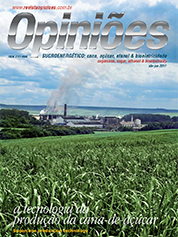Ivan Chaves de Sousa
Director of Chaves Planejamento e Consultoria
Op-AA-28
What is the cost of a ton of cane?
How much does it cost to produce a ton of sugarcane? Difficulties faced in recent harvests were numerous, therefore it isn’t easy to find the right answer for this question. Extreme low prices, severe climate adversities affecting harvests, and the acute financial crisis in 2008, were, along with others, the factors that shacked the production process routine, bringing about cost increases in the last few years.
Let us not forget recently implemented projects, still in the operational adjustment phase. In this turbulent context, perhaps we should rephrase the question, inverting it: what should our production cost be in light of the prices practiced in the market?
Let us remember that sugarcane is paid according to the quantity of sugars (ATR in Portuguese: Total Recoverable Sugars) contained in this raw material destined to the production of sugar and ethanol. According to the rules of Consecana, that guide calculations of sugarcane value, ATR prices vary in the same proportion of variations in the prices of the end products sugar and ethanol.
Thus, this is the best of worlds for the sugarcane producer: to achieve excellent ATR productivity per harvested hectare and excellent prices for his production. This is the time to ask: what prices has the market practiced in the industry in recent years? The harvest season 2010/11, in the State of São Paulo, indicated an average price equivalent of R$ 0.4022 per kg of ATR (source: Consecana).
A simple comparison, considering the last ten harvest seasons, indicates a value close to R$ 0.37 per kg of ATR as the average price, at values of March/2011 (calculation sources: Consecana bulletins and the IGPM index published by FGV’s Revista Conjuntura Econômica, for value updating). Thus, there truly was a price recovery in the industry in 2010/11. In due time: we might admit that these price levels are applicable to all other states of the Center-South region.
With that said, what would the remuneration per ton of sugarcane be? It would depend on ATR content in sugarcane, of course. Considering average concentration of sugar equivalent at 145 kg ATR/t cane, one would have a price of R$ 53.65/t cane (for the average “historical” ATR price of R$ 0.37/kg), that would increase to R$ 58.32/t cane if the calculation were based on the average TRS price in the last year of the harvest season in the State of São Paulo.
Our surveys conducted in mills in the Center-South region show that their costs, on average, in recent years, have been slightly above this price range. One must recall the difficulties pointed out at the beginning of this article, adversely affecting these companies’ performance.
But, there are exceptions. Therefore, let us consider two cost and productivity levels, based on our observations in this region. There is a group of companies that, for several reasons, has at least partially overcome such difficulties: it displays well managed costs of its production process and achieves good productivity ratings (for example, 88.0 t cane/cut ha).
According to our analyses, this group of mills is apparently capable of producing cane at a cost close to R$ 52.00/ton. Therefore, in comparison with the mentioned prices, it is apparently slightly ahead in terms of a positive margin. Not seldom – actually quite to the contrary – we find companies producing sugarcane at slightly higher costs, also due to the mentioned difficulties.
Combining this condition with lower productivity (for example, 82t/cane/cut/ha), the unit production cost of these companies would reach R$ 63.00 per ton of sugarcane. Or even more, depending on circumstances, which is to say, they make a loss. Let us re-emphasize: these are mills located in the Center-South region.
In this scenario, can one expect market recovery to progress firmly and favorably? Or should we endeavor to make our companies more competitive? Logic tells us to concentrate all our efforts on the second alternative, given that market sensitiveness will be outside of our control.
The recipe to improve results is simple: to produce more sugar per harvested hectare at lower costs. But how? By offering a wide range of measures, encompassing the perfecting of the business management model, replacing agricultural practices with new more efficient ones, developing training and motivational programs for staff, bringing about continuous improvement by adopting new benchmarks, etc.
Another measure is to demand of one’s different production input suppliers: more productive and resistant sugarcane varieties, better, and better performing equipment, mainly in the planting and harvesting phases, and so on and so forth. If the reader is to go this route in search of means to strengthen a company, one final recommendation: be humble, because “wise is who captures the wisdom of all others” (Juan Guerra Caçeres).




